Tuesday 21 October 1941
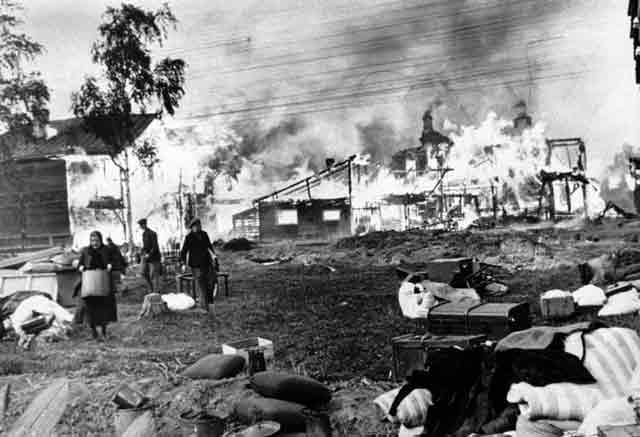 |
| Russian civilians carry their belongings from their burning homes, allegedly set on fire by retreating Soviet troops as part of a scorched-earth policy, in a Leningrad suburb on October 21, 1941. The German propaganda service had a standing policy of releasing these types of photos to American journalists in Lisbon (AP Photo). |
Eastern Front: The weather in northern and central Russia has been deteriorating for two weeks as of
21 October 1941, with intermittent snow and rain as the temperature hovers around freezing. The snow has not been sticking, but as it melts, it has been exacerbating a problem with German transportation that was only a nuisance during the summer.
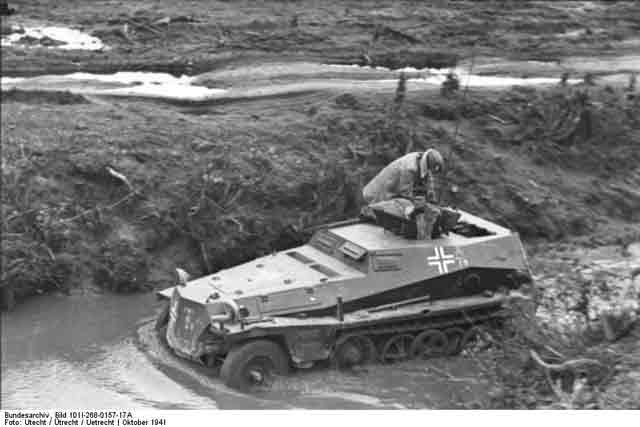 |
| German light armored observation car (Sd.Kfz. 253) caught by rising waters, October 1941 (Utrecht, Fred Erich, Federal Archive Bild 101I-268-0157-17A). |
The dirt roads were manageable during the summer and fall, even if uncomfortably dusty, but all of the water both from precipitation on the roads and runoff from surrounding areas into low-lying routes now is becoming a real problem. This is the "Rasputitsa," the muddy season that occurs every spring and fall during the change of seasons. The weather always is a very important factor in the campaign on the Eastern Front, helping both sides at times but favoring the Soviets when it counts the most.
 |
| Gertrud Scholtz-Klink at the opening of an exhibit about the work of German women in Luxembourg on 21 October 1941. Frau Scholtz-Klink was head of all Third Reich women's organizations such as the BDM. She was an unrepentant supporter of Hitler until her death on 24 March 1999. Ever wonder where Colonel Klink from Hogan's Heroes got his name from? Nobody is sure, but this was the most highly placed official in the Third Reich with that name. |
The Soviets are used to the Rasputitsa, of course, but it is a new and unexpected phenomenon for German soldiers who have never before had the slightest interest in Russia. The deep mud slows the German supply trucks to a halt. The truck drivers attempt to go around the puddles and streams flowing across the roads, but they just extend the ruts further out until areas 50 meters across in places become impassable quagmires. Even horses get stuck, and men marching through the muddy stretches sometimes lose their boots. It is not as if the weather only affects the Wehrmacht, but the Russians have two advantages: their equipment is adapted to the conditions, and they are only attempting to hold their ground for the moment. On days like this, little happens, which may be confusing when other days show major German gains, but the impact of the weather cannot be denied during World War II.
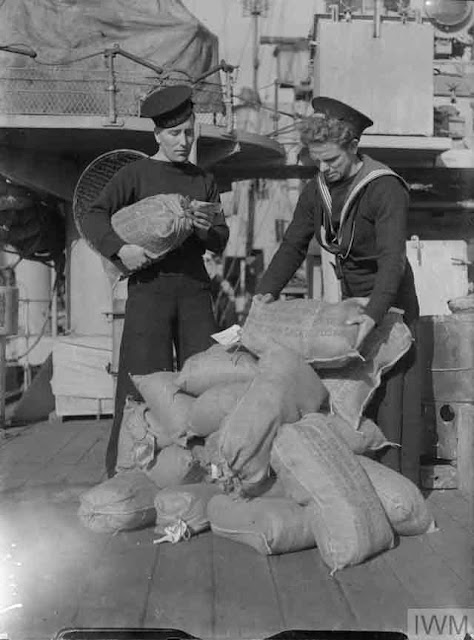 |
| "Emergency rescue kits supplied by the Merchant Navy Comforts Service arriving onboard HMS DEPTFORD." 21 October 1941. The Wehrmacht troops on the Eastern Front certainly wouldn't mind having this warm clothing delivered to them right about now, but German officials are of the opinion that supplying it would be bad for morale © IWM (A 6188). |
Of course, the weather does not stop everything, especially in the south where the Rasputitsa is not as dramatic and hits a little later. General von Manstein's 11th Army continues advancing deep into the Perekop Isthmus in the entrance to the Crimea, and units of Sixth Army approach within seven miles of the key industrial city of Kharkiv. The Soviets in Kharkiv are busy also, finishing the loading of the Kramatorsk heavy-machine factory equipment onto railcars for a hurried move to the Urals. The factory workers are not as valuable as the equipment, so they must walk the first 20 miles to another train station. However, as good Communists, they are only too happy to do what comrade Stalin wants.
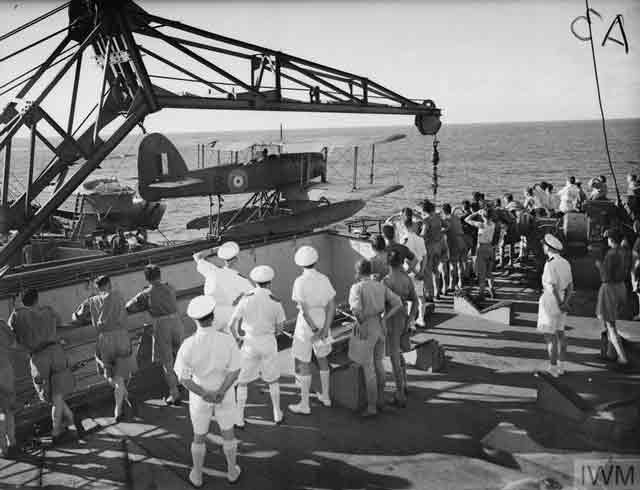 |
| "A Fairey Seafox being catapulted from HMS CANTON in the Atlantic." 21 October 1941 © IWM (A 6653). |
Stalin, meanwhile, has been watching the Wehrmacht approaching Moscow from three different directions - northwest, west, and southwest - with growing alarm. In moments of crisis, Stalin always turns to a trusted handful of men who may not be infallible, but at least remain completely loyal through thick and thin. Today, he elevates General Georgy Zhukov, his most competent officer, from command of the West Front to command of all military forces in the Moscow defensive area. It is not so much that Zhukov is the world's most brilliant strategist or tactician that makes him effective as it is that he has Stalin's complete confidence. This gives Zhukov more discretion to "assume" what Stalin wants than any other officer - though, of course, this has its limits as well. As Zhukov later puts it, there is as much distance between him and Stalin as there is between a field marshal and the lowliest private. A somewhat similar to the situation that later develops in the Wehrmacht between Hitler and Field Marshals von Manstein and Model, but Zhukov's relationship with Stalin is unique.
 |
| A Wehrmacht soldier testifying to a military tribunal in France regarding an attack on a German soldier by three Frenchmen, 18 October 1941 (Trautvetter, Federal Archive Picture 146-2007-0126). |
However limited his real authority may be, Zhukov's relationship of confidence with Stalin gives him more call on the Soviet Union's abundant resources and more latitude to take chances with strategy than any other general. The problem for Stalin, though, is that there are multiple military problems to solve - at Leningrad, on the Volkhov River north of Moscow, in the Crimea, at Kharkiv, and at Rostov-on-Don - and there is only one Zhukov. Stalin keeping Zhukov at Moscow when there are so many other critical places in peril is perhaps the ultimate vindication of the many German generals who urged Hitler to focus on the Soviet capital throughout 1941.
 |
| German soldiers have Roma children shine their boots before shooting them together with about 2300 other hostages in Kragujevac, Serbia on 21 October 1941 (this was the figure reported to his superiors by General der Pioniere (Lieutenant General) Walter Kuntze). These were reprisals for an attack by Serbian partisans on 15-16 October at Kraljevo (10 km south of Belgrade) in which 10 German soldiers were killed and 14 wounded. The commander of the 717th Infantry Division, Generalmajor (Brigadier General) Paul Hoffman, personally supervised the killings. As happened now and then, including a more famous incident on Crete, one German soldier was shot for refusing to participate in the killings. |
US/Japanese Relations: With General Tojo now the Japanese Prime Minister, everyone with a basic understanding of Japanese politics realizes that the war party is in control in Tokyo. However, everyone also knows that the Emperor continues to desire peace. Accordingly, the Foreign Office sends out a very mixed message to Ambassador Kichisaburō Nomura in Washington that contains an obvious hint of menace:
The new cabinet differs in no way from the former one in its sincere desire to adjust Japanese-United States relations on a fair basis. Our country has said practically all she can say in the way of expressing of opinions and setting forth our stands. We feel that we have now reached a point where no further positive action can be taken by us except to urge the United States to reconsider her views. We urge, therefore, that, choosing an opportune moment, either you or Wakasugi let it be known to the United States by indirection that our country is not in a position to spend much more time discussing this matter. Please continue the talks, emphasizing our desire for a formal United States counter-proposal to our proposal of 25 September.
Nomura is also a member of the "peace faction' has been doing everything that he can to defuse a conflict. This has included numerous official and off-the-record meetings with top American officials such as U.S. Secretary of State Cordell Hull. While he may not convey the obvious threat implied in these instructions, the Americans are reading the Japanese diplomatic codes and certainly are in a position to get the message whether Nomura tells them or not.
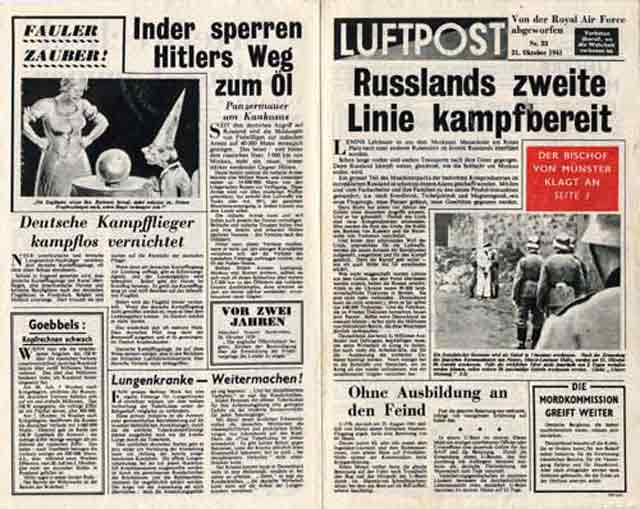 |
| EH.510/23, Luftpost (British propaganda leaflet), Nr. 23, 21. Oktober 1941 (Luftpost, No. 23, 21 October 1941) (Image/s source: www.psywar.org). |
American Homefront: Two of the most iconic characters in comic book history debut on 21 October 1941. Wonder Woman appears in "All-Star Comics" issue #8 (cover date December 1941/January 1942), scripted by William Moulton Marston, a psychologist already famous for inventing the polygraph (lie detector). The Penguin (Oswald Chesterfield Cobblepot) from the Batman comic book series appears in "Detective Comics" issue #58 (cover date December) and is created by Bob Kane and Bill Finger. Both the Penguin and Wonder Woman eventually make their way into television series, motion pictures, and other media such as video games.
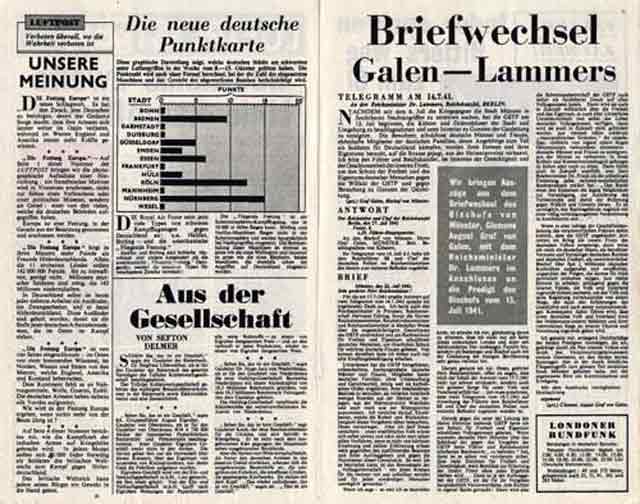 |
| EH.510/23, Luftpost, Nr. 23, 21. Oktober 1941 (Luftpost, No. 23, 21 October 1941) (Image/s source: www.psywar.org). |
October 1941
October 1, 1941: Germans and Finns Advance in USSR
October 2, 1941: Operation Typhoon Broadens
October 3, 1941: Air Battles Near Moscow
October 4, 1941: Stalin Contemplates Defeat
October 5, 1941: Hoth Goes South
October 6, 1941: First Snowfall After Dark
October 7, 1941: Stalin Gets Religion
October 8, 1941: FDR Promises Stalin Aid
October 9, 1941: FDR Orders Atomic Bomb Research
October 10, 1941: Reichenau's Severity Order
October 11, 1941: Tank Panic in Moscow
October 12, 1941: Spanish Blue Division at the Front
October 13, 1941: Attack on Moscow
October 14, 1941: Germans Take Kalinin
October 15, 1941: Soviets Evacuate Odessa
October 16, 1941: Romanians Occupy Odessa
October 17, 1941: U-568 Torpedoes USS Kearny
October 18, 1941: Tojo Takes Tokyo
October 19, 1941: Germans Take Mozhaysk
October 20, 1941: Germans Attack Toward Tikhvin
October 21, 1941: Rasputitsa Hits Russia
October 22, 1941: Germans Into Moscow's Second Defensive Line
October 23, 1941: The Odessa Massacre
October 24, 1941: Guderian's Desperate Drive North
October 25, 1941: FDR Warns Hitler About Massacres
October 26, 1941: Guderian Drives Toward Tula
October 27, 1941: Manstein Busts Loose
October 28, 1941: Soviet Executions
October 29, 1941: Guderian Reaches Tula
October 30, 1941: Guderian Stopped at Tula
October 31, 1941: USS Reuben James Sunk
2020









No comments:
Post a Comment